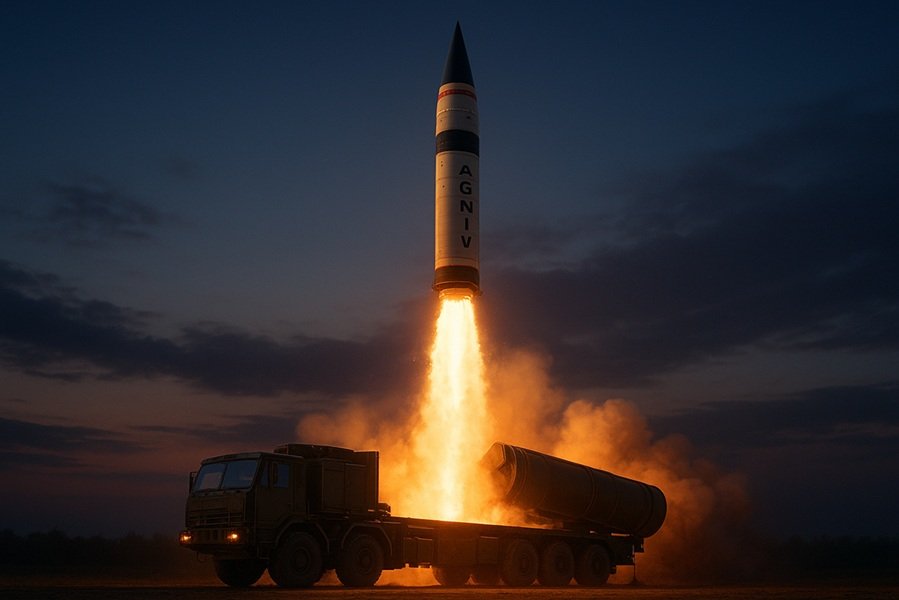
Introduction
Agni-V is India’s most advanced and powerful intercontinental ballistic missile (ICBM), developed by the Defence Research and Development Organisation (DRDO). With a range of over 5,000 kilometers, Agni-V significantly enhances India’s strategic deterrence capability by bringing almost the entire Asian continent, parts of Europe, and other regions within its reach. The successful development and induction of this missile have placed India in an elite group of countries possessing long-range nuclear-capable ballistic missiles, alongside the United States, Russia, China, France, and the United Kingdom.
Development of Agni-V
The Agni missile program was launched in the 1980s as part of India’s Integrated Guided Missile Development Program (IGMDP). Over time, India developed a family of Agni missiles with increasing ranges:
- Agni-I: 700 – 1,200 km
- Agni-II: 2,000 – 2,500 km
- Agni-III: 3,500 – 5,000 km
- Agni-IV: ~4,000 km
- Agni-V: 5,000+ km
Agni-V represents a technological leap, not just in terms of range but also with its advanced navigation systems, composite materials, and multiple warhead capability (MIRV – Multiple Independently Targetable Re-entry Vehicles).
The first successful test of Agni-V took place on April 19, 2012, from Wheeler Island (now Dr. Abdul Kalam Island), Odisha. Since then, multiple developmental and user trials have been successfully conducted.
Technical Specifications of Agni-V
| Feature | Details |
|---|---|
| Type | Intercontinental Ballistic Missile (ICBM) |
| Developer | DRDO, India |
| Range | 5,000 – 5,500 km (can be extended further) |
| Warhead | Nuclear-capable, 1.5 tons payload |
| Stages | Three-stage, solid-fueled |
| Length | ~17.5 meters |
| Diameter | 2 meters |
| Launch Weight | ~50 tons |
| Propulsion | Solid propellant in all three stages |
| Accuracy (CEP) | Very high, due to advanced ring laser gyroscopes and micro-navigation systems |
| Mobility | Can be launched from road-mobile platforms |
| Special Capability | Can be equipped with MIRV technology |
Key Features and Advancements
1. Intercontinental Range
With a range exceeding 5,000 km, Agni-V can reach strategic targets deep inside Asia and even parts of Europe and Africa. This places it in the true category of an ICBM, strengthening India’s nuclear deterrence.
2. Solid Fuel Technology
Unlike older liquid-fuel missiles, Agni-V uses solid propellants in all three stages, ensuring greater reliability, longer storage life, and quick launch readiness.
3. Mobility and Flexibility
The missile can be launched from canister-based road-mobile systems, making it difficult to detect and providing India with a second-strike capability in case of a nuclear attack.
4. MIRV Technology
Agni-V can potentially carry Multiple Independently Targetable Re-entry Vehicles (MIRVs), allowing it to deliver several nuclear warheads to different targets with a single launch. This makes missile defense systems less effective against it.
5. High Accuracy
The missile is equipped with ring laser gyroscopes and micro-inertial navigation systems, providing exceptional accuracy in striking targets.
Strategic Importance of Agni-V
1. Nuclear Deterrence
Agni-V strengthens India’s credible minimum deterrence under its No-First-Use (NFU) nuclear policy. It ensures that adversaries think twice before considering any large-scale aggression.
2. Counterbalance to China
The missile’s range allows India to cover almost all major cities and strategic locations in China, including Beijing, Shanghai, and Guangzhou, making it a crucial counterbalance in the Indo-Pacific region.
3. Geopolitical Impact
By developing Agni-V, India has entered the exclusive club of nations with ICBM capability. This elevates India’s status as a global power and enhances its influence in international security affairs.
4. Strengthening Second-Strike Capability
The road-mobile, canisterized system ensures survivability and allows India to launch a retaliatory strike even if its fixed missile silos are targeted in a first strike.
Tests and Induction Timeline
- 2012 – First successful test launch.
- 2013–2015 – Multiple developmental tests proved reliability and accuracy.
- 2016–2018 – User trials conducted by the Strategic Forces Command (SFC).
- 2018 onwards – Gradual induction into India’s nuclear arsenal.
- 2021–2023 – Advanced versions with MIRV capability tested, enhancing India’s deterrence posture.
Comparison with Other ICBMs
| Country | Missile | Range | MIRV Capability |
|---|---|---|---|
| India | Agni-V | 5,000 – 5,500 km | Yes (future-ready) |
| USA | Minuteman III | 13,000 km | Yes |
| Russia | RS-28 Sarmat | 18,000 km | Yes |
| China | DF-41 | 12,000 – 15,000 km | Yes |
| France | M51 | 10,000 km | Yes |
| UK | Trident II (shared with USA) | 12,000 km | Yes |
Though Agni-V’s range is shorter compared to the U.S. and Russian ICBMs, it is adequate for India’s security requirements, especially against regional adversaries.
Future Developments – Agni-VI
India is already working on Agni-VI, the successor to Agni-V. Reports suggest it will have a range of 8,000–12,000 km with advanced MIRV and MARV (Maneuverable Re-entry Vehicle) capabilities, making it even more potent.
Conclusion
Agni-V marks a milestone in India’s defense capabilities, symbolizing technological advancement, self-reliance, and strategic strength. Its intercontinental reach, nuclear capability, and survivability make it a cornerstone of India’s nuclear doctrine. As India continues to modernize its defense systems, Agni-V ensures the nation’s security, deterrence credibility, and strategic stability in an increasingly complex global order.







